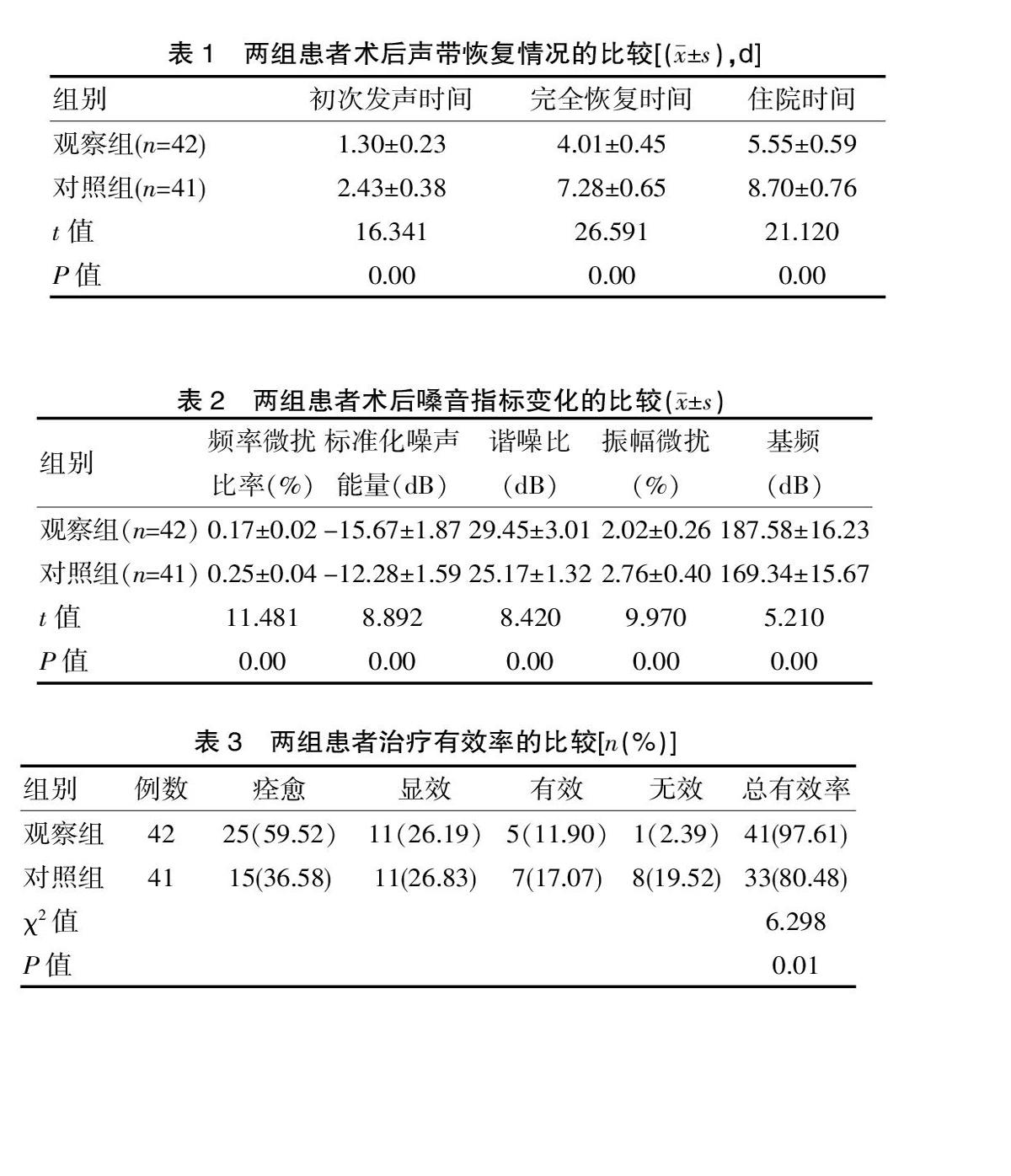支撑喉镜下二氧化碳激光切除术和常规切除治疗声带息肉的临床效果对比
2019-08-01徐嘉温延辉谢晓梅
徐嘉 温延辉 谢晓梅

[摘要] 目的 研究比較支撑喉镜下二氧化碳激光切除术以及常规切除术治疗声带息肉的临床效果。方法 方便选取该院2017年8月—2018年10月收治的声带息肉的患者83例,随机数字法分为两组,观察组患者42例,对照组患者41例,观察组患者进行支撑喉镜下二氧化碳激光切除术治疗,对照组患者进行支撑喉镜下常规切除治疗。治疗结束后,观察比较两组患者的声带恢复情况、两组患者的嗓音学变化的指标以及两组患者的不良反应情况。 结果 观察组患者的住院康复时间、完全恢复时间以及初次发声时间较对照组患者显著降低,差异有统计学意义(t=21.120、26.591、16.341,P<0.05)。观察组患者的频率微扰比率、标准化噪声能量、谐噪比、振幅微扰及基频等嗓音学指标变化显著优于对照组患者,差异有统计学意义(t=11.481、8.892、8.420、9.970、5.210,P<0.05)观察组患者的治疗有效率(97.61%)显著高于对照组患者(80.48%),差异有统计学意义(χ2=6.298,P<0.05)。两组患者的不良反应发生率比较差异无统计学意义(χ2=0.608,P>0.05)。结论 支撑喉镜下二氧化碳激光切除术和常规切除术均可治疗声带息肉,手术均较安全,但是使用二氧化碳激光切除的声带恢复更快,声带功能恢复的更好。
[关键词] 支撑喉镜下二氧化碳激光切除术;初次发声时间;声带息肉;嗓音学
[中图分类号] R767.4 [文献标识码] A [文章编号] 1674-0742(2019)04(c)-0070-03
[Abstract] Objective To study and compare the clinical effects of carbon dioxide laser resection and conventional resection under self-retaining laryngoscope in the treatment of vocal cord polyps. Methods A total of 83 patients with vocal cord polyps admitted to our hospital from August 2017 to October 2018 were randomly divided into two groups, 42 patients in the observation group and 41 patients in the control group. The patients in the observation group were treated with carbon dioxide laser resection under the support laryngoscope, while the patients in the control group were treated with conventional resection under the support laryngoscope. After treatment, vocal cord recovery, voice changes and adverse reactions were observed and compared between the two groups. Results The inpatient rehabilitation time, complete recovery time, and initial vocalization time of the observation group were significantly shorter than those of the control group, and the difference was statistically significant (t=21.120, 26.591, 16.341, P<0.05). The frequency perturbation ratio, standardized noise energy, harmonic noise ratio, amplitude perturbation and fundamental frequency of the observation group were significantly better than those of the control group, and the difference was statistically significant (t=11.481, 8.892, 8.420, 9.970, 5.210, P<0.05). The effective rate of the observation group (97.61%) was significantly higher than that of the control group (80.48%), and the difference was statistically significant (χ2=6.298,P<0.05). There was no significant difference in the incidence of adverse reactions between the two groups (χ2=0.608,P>0.05). Conclusion Carbon dioxide laser resection and conventional laryngoscope resection can treat vocal cord polyps. Both of the two methods are is safer. But the recovery of vocal cord after carbon dioxide laser resection is faster and the recovery of vocal cord function is better.
